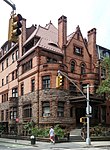Fort Brooklyn
1780 establishments in New York (state)1823 disestablishments in New York (state)18th century in BrooklynAmerican Revolutionary War fortsBritish forts in the United States ... and 7 more
Brooklyn HeightsBuildings and structures demolished in 1823Colonial forts in New York (state)Demolished buildings and structures in BrooklynForts in New York CityMilitary installations established in 1780New York (state) in the American Revolution
Fort Brooklyn was a British-built large star fort built to support the occupation of Brooklyn during the American Revolutionary War. The site was on Brooklyn Heights, near present-day Pierrepont and Henry Streets, about four blocks from Fort Stirling. The fort was 450 feet square with ramparts 40 to 50 feet above the bottom of an encircling ditch. Each angle had a bastion and there was a substantial barracks and two magazines. After the British evacuation the fort was leveled between 1823 and 1825 for development.
Excerpt from the Wikipedia article Fort Brooklyn (License: CC BY-SA 3.0, Authors).Fort Brooklyn
Pierrepont Street, New York Brooklyn
Geographical coordinates (GPS) Address Nearby Places Show on map
Geographical coordinates (GPS)
| Latitude | Longitude |
|---|---|
| N 40.6955 ° | E -73.994 ° |
Address
Pierrepont Street 85
11201 New York, Brooklyn
New York, United States
Open on Google Maps








